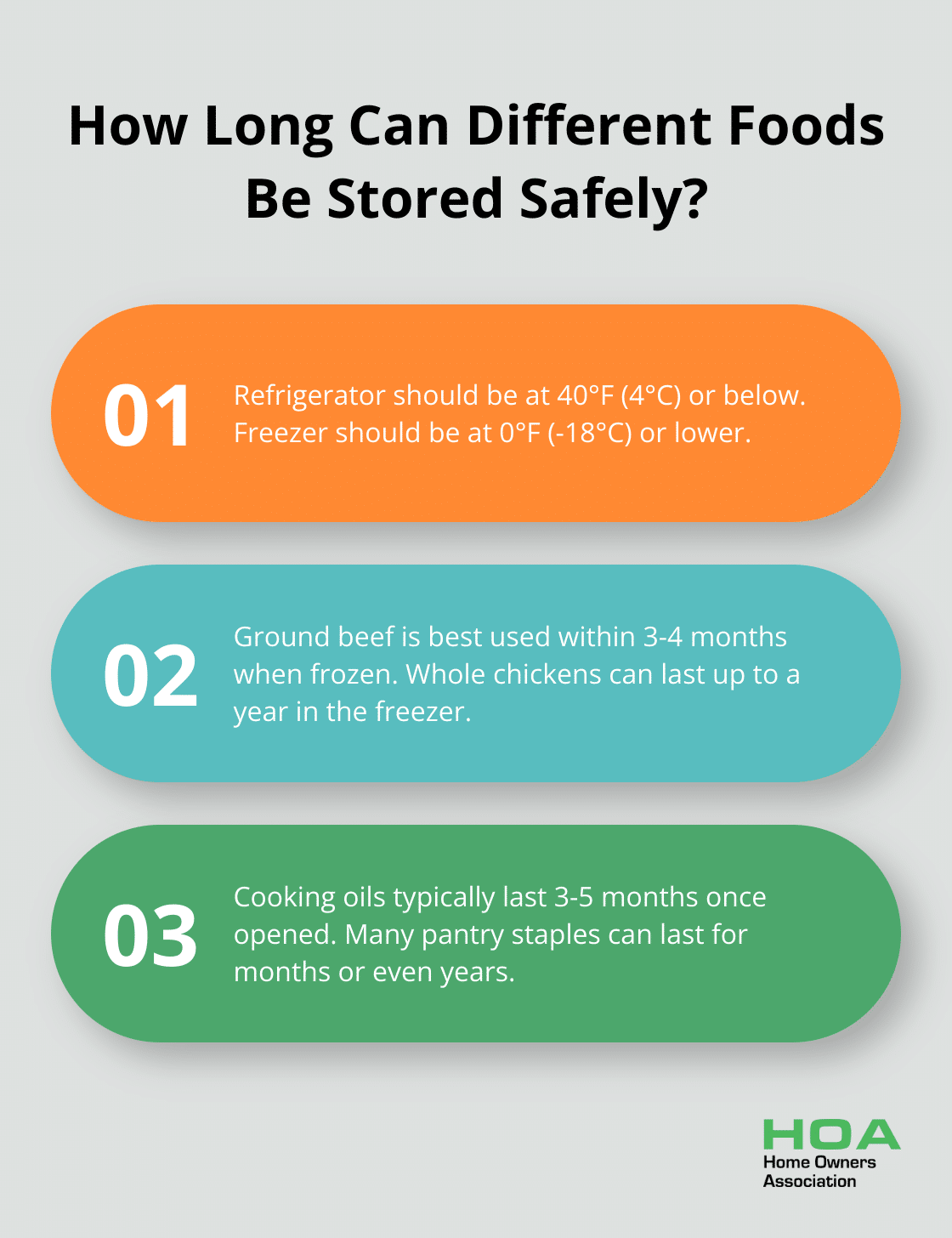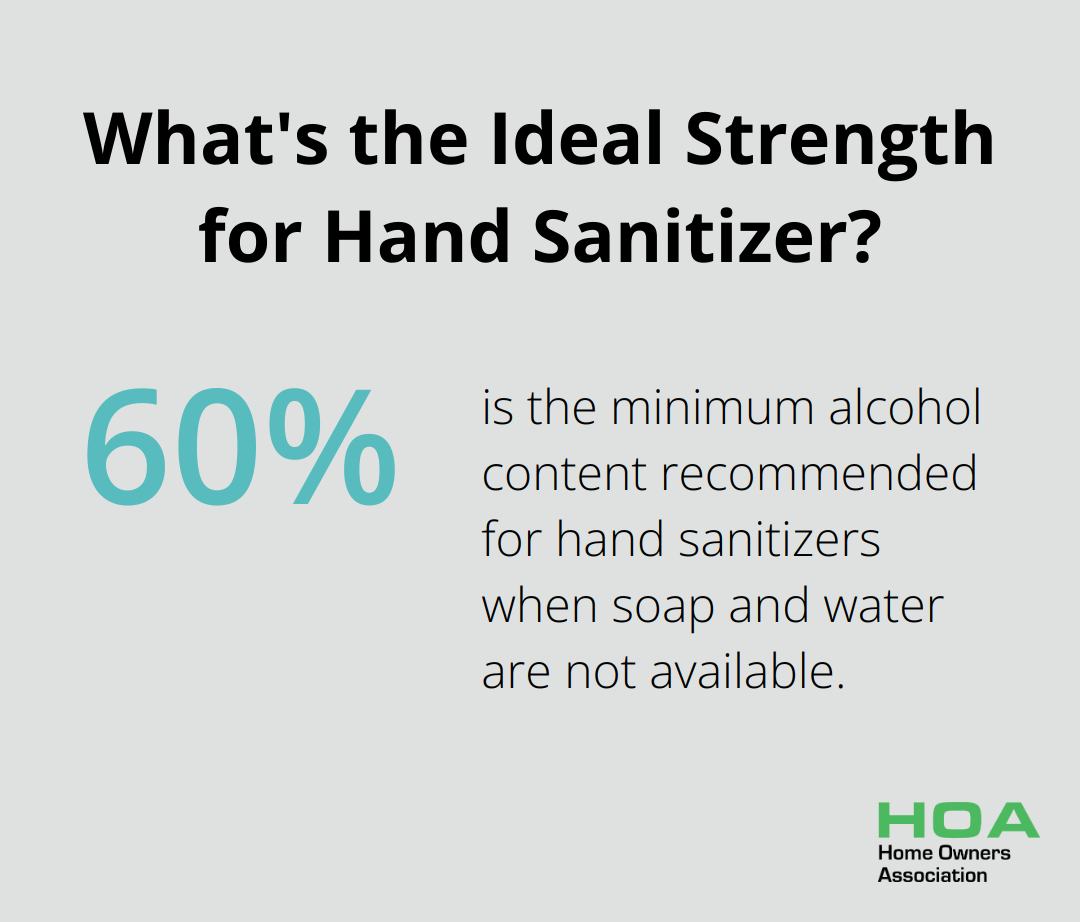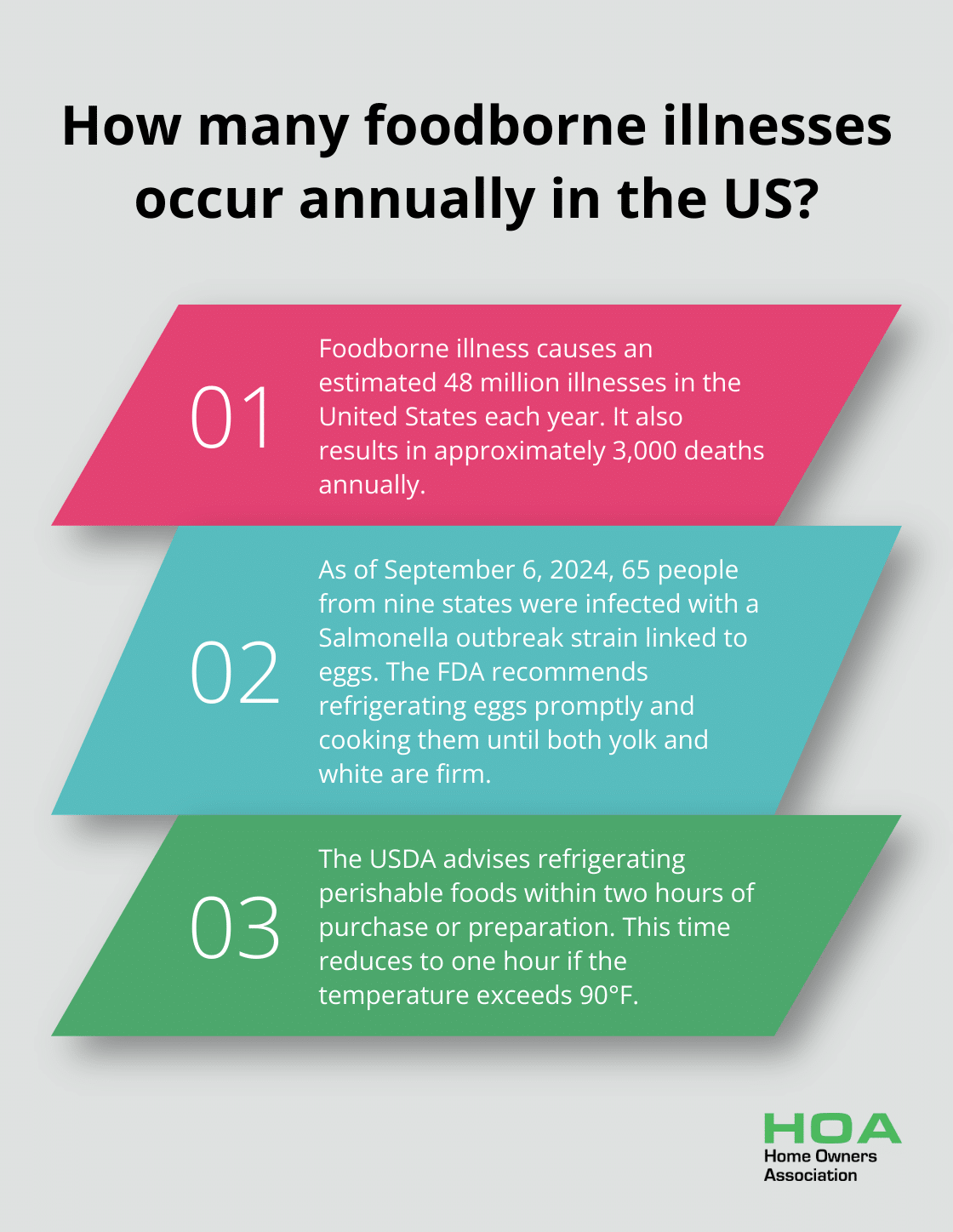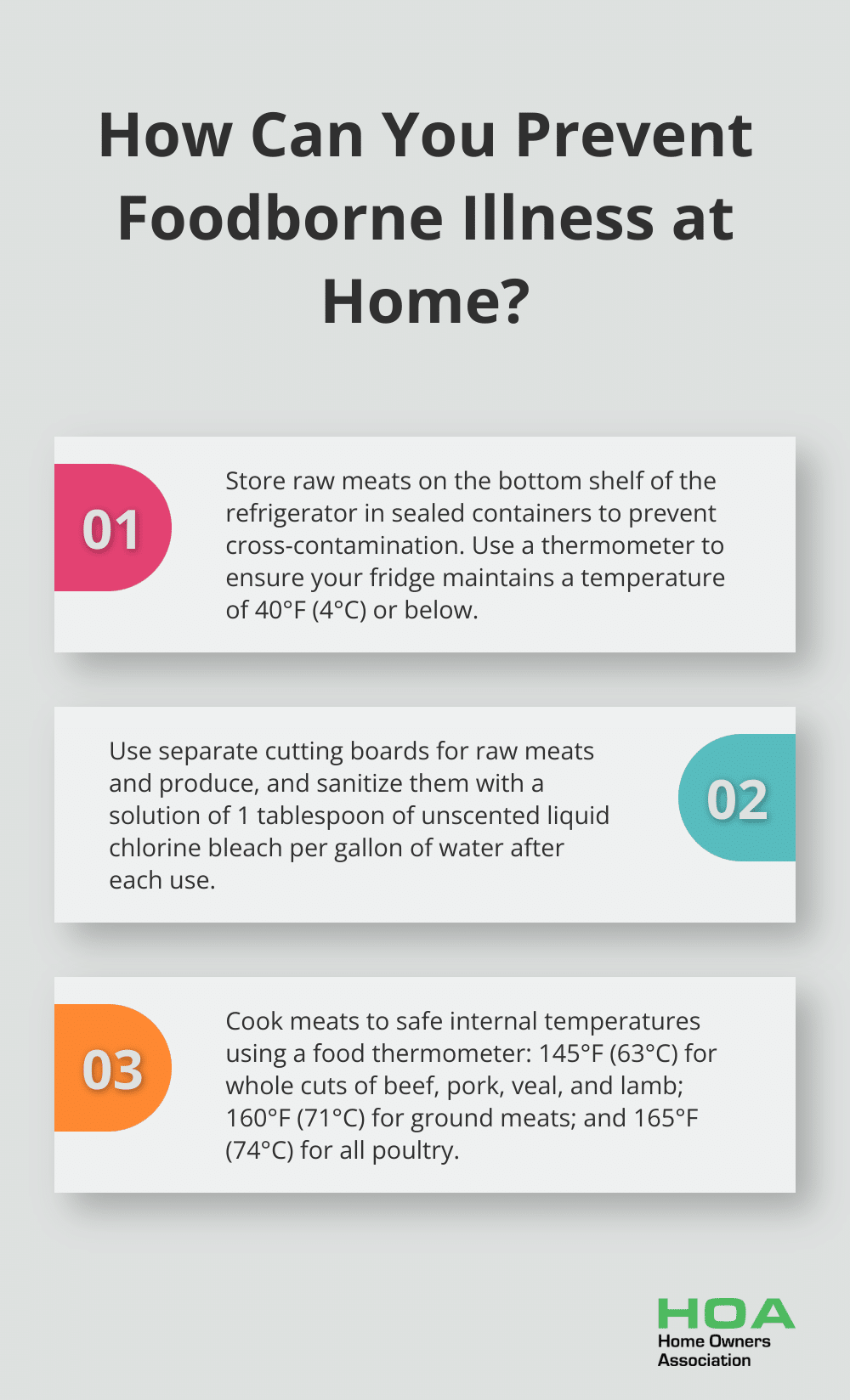
At Home Owners Association, we understand the importance of maintaining a safe and healthy home environment. Food safety practices at home are a critical aspect of this, yet they’re often overlooked.
In this blog post, we’ll explore essential techniques for proper food storage, safe preparation methods, and ways to prevent foodborne illnesses. By implementing these practices, you can protect your family’s health and enjoy worry-free meals in your home.
How to Store Food Safely at Home
At Home Owners Association, we know that proper food storage is essential for a healthy kitchen. Effective storage practices prevent foodborne illnesses and reduce food waste. Let’s explore practical techniques to keep your food fresh and safe.
Master Refrigeration and Freezing
Your refrigerator should maintain a temperature of 40°F (4°C) or below, while your freezer should be at 0°F (-18°C) or lower. Check these temperatures regularly with a thermometer. Store raw meats on the bottom shelf to prevent juices from dripping onto other foods. Wrap or cover foods tightly to maintain moisture and prevent odors from spreading.

When you freeze foods, use freezer-safe containers or heavy-duty freezer bags. Label items with the date of freezing to track freshness. Most frozen foods remain safe indefinitely, but quality decreases over time. Ground beef is best used within 3-4 months, while whole chickens can last up to a year.
Organize Your Pantry for Longevity
A well-organized pantry makes cooking easier and ensures food safety. Store dry goods like flour, sugar, and rice in airtight containers to prevent moisture and pests. Place newer items at the back and older ones in front to practice the “first in, first out” method.
Be aware of shelf life. While many pantry staples last for months or even years, items like cooking oils typically last only 3-5 months once opened. Store nuts and seeds in the refrigerator to prevent rancidity. Check expiration dates regularly and discard any items that show signs of spoilage (such as unusual odors or mold).
Prevent Cross-Contamination
Cross-contamination is a leading cause of foodborne illness. To keep your family safer from food poisoning, follow these four simple steps: clean, separate, cook, and chill. In your refrigerator, store raw meats, poultry, and seafood on the bottom shelf in sealed containers or plastic bags to prevent juices from dripping onto other foods. Keep eggs in their original carton and store them in the main body of the refrigerator, not in the door where temperatures fluctuate.
In the pantry, store cleaning products and chemicals separately from food items. Use different cutting boards for raw meats and produce, and wash them thoroughly after each use. The FDA recommends using a solution of 1 tablespoon of unscented, liquid chlorine bleach per gallon of water to sanitize cutting boards and other food preparation surfaces.
Now that you’ve learned how to store food safely, let’s move on to the next critical step in food safety: proper preparation methods. These techniques will help you maintain the safety of your food from storage to plate.
How to Prepare Food Safely at Home
The Foundation of Hand Hygiene
At Home Owners Association, we prioritize safe food preparation as a cornerstone of a healthy household. Clean hands form the first defense against food contamination. The Centers for Disease Control and Prevention (CDC) advises washing hands with soap and water for about 15-30 seconds before and after handling food. This simple act can significantly reduce the risk of foodborne illness.

Wash your hands after touching raw meat, using the bathroom, or handling pets. If soap and water aren’t available, use an alcohol-based hand sanitizer (containing at least 60% alcohol).
Maintain a Spotless Kitchen
A clean kitchen prevents food contamination. Sanitize your countertops, cutting boards, and utensils regularly. The United States Department of Agriculture (USDA) recommends a solution of 1 tablespoon of unscented, liquid chlorine bleach per gallon of water to disinfect surfaces.
Focus on your cutting boards. Use separate boards for raw meats and produce to avoid cross-contamination. Replace cutting boards with deep grooves or cuts, as these can harbor bacteria.
Master Safe Thawing Techniques
Proper food thawing prevents bacterial growth. The FDA approves three safe methods:
- In the refrigerator
- In cold water
- In the microwave
Never thaw food on the counter, as this allows bacteria to multiply rapidly.
Cook to Safe Temperatures
Temperature plays a vital role in food safety. Use a food thermometer to ensure meats reach safe internal temperatures. The USDA provides these guidelines:
- Beef, pork, veal, and lamb: 145°F (63°C)
- Ground meats: 160°F (71°C)
- Poultry: 165°F (74°C)
- Fish: 145°F (63°C)
Color does not indicate doneness reliably. Always use a thermometer for accuracy.
Implement Safe Cooling Practices
After cooking, cool food quickly to prevent bacterial growth. Divide large portions into smaller containers for faster cooling. Refrigerate perishable foods within two hours of cooking (or within one hour if the temperature is above 90°F).
These practices significantly reduce the risk of foodborne illnesses in your home. Safe food preparation requires attention to detail and consistency. Let’s now explore specific strategies for preventing foodborne illnesses and identifying high-risk foods in the next section.
How to Prevent Foodborne Illnesses at Home
Identify and Handle High-Risk Foods Carefully
Certain foods are more prone to harboring harmful bacteria. Raw or undercooked meats, poultry, and seafood top this list. Foodborne illness is a preventable public health challenge that causes an estimated 48 million illnesses and 3,000 deaths each year in the United States. Cook these items thoroughly and avoid cross-contamination with other foods.

Eggs pose another high risk. As of September 6, 2024, a total of 65 people infected with the outbreak strain of Salmonella have been reported from nine states. Refrigerate eggs promptly and cook them until both the yolk and white are firm.
Unpasteurized dairy products and juices can also pose risks. Choose pasteurized versions to reduce the chance of bacterial contamination.
Recognize Signs of Food Spoilage
Early detection of spoiled food prevents illness. Trust your senses. Unusual odors, colors, or textures indicate problems. Discard moldy bread entirely, as mold can penetrate deeper than what’s visible on the surface.
With canned goods, watch for signs of botulism. The USDA warns that bulging cans, leaking seals, or a hissing sound upon opening indicate potential contamination. Never taste food to determine if it’s safe – if you doubt its safety, throw it out.
Practice Proper Food Handling and Storage
Maintain the cold chain. The FDA advises refrigeration of perishable foods within two hours of purchase or preparation (one hour if the temperature exceeds 90°F). Use a refrigerator thermometer to ensure your fridge stays at or below 40°F.
When you prepare meals, cool food quickly before refrigerating. The USDA recommends division of large amounts of food into shallow containers for rapid cooling. This prevents the growth of bacteria that thrive in the “danger zone” (between 40°F and 140°F).
Pay attention to expiration dates, but understand their meaning. “Best by” dates indicate quality, not safety. However, follow “Use by” dates on perishables like meat and dairy strictly to avoid potential illness.
Educate Family Members on Food Safety
Make food safety a family affair. Teach children about proper handwashing techniques and safe food handling practices. Encourage everyone to participate in maintaining a clean kitchen and proper food storage.
Stay Informed About Food Recalls
Keep yourself updated on food recalls and safety alerts. Sign up for email notifications from food safety organizations or follow their social media accounts. This proactive approach helps you avoid potentially contaminated products.
Final Thoughts
Food safety practices at home protect your family from foodborne illnesses. Store food properly, maintain clean hands and surfaces, and cook to safe temperatures. Identify high-risk foods, recognize spoilage signs, and stay informed about recalls to further reduce risks.

Consistent application of these practices will create a safer food environment in your home. Visit the FDA, USDA, and CDC websites for up-to-date guidelines and resources on food safety. These organizations provide valuable information to help you maintain a safe kitchen.
At Home Owners Association, we support Melbourne homeowners in creating safe living spaces. Our members receive expert advice, resources, and discounts on home improvement materials. Prioritize food safety in your home to enhance overall household well-being.





